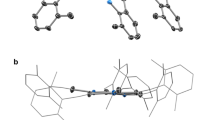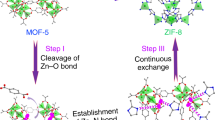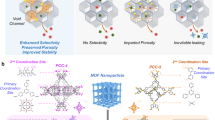Abstract
The creation of metal nanoclusters with dimensions ranging from subnanometre to ~2 nm for heterogeneous catalysis has received substantial attention. However, synthesizing these structures while retaining surface activity and avoiding aggregation is challenging. Here, we report a reverse double-solvents approach that enables encapsulation of highly catalytically active Pd nanoclusters inside the newly formed discrete organic molecular cage, RCC3. By encapsulating within the open cavities of soluble RCC3 cages, the obtained Pd nanocluster cores are produced with precisely controlled size (~0.72 nm) and show high solubility, excellent dispersibility and accessibility in solution, presenting significantly enhanced catalytic activities towards various liquid-phase catalytic reactions. Moreover, owing to the effective confinement of cage cavities, the as-prepared Pd nanoclusters possess excellent stability and durability. The strategy of encapsulation of metal nanoclusters within soluble porous organic cages is promising for developing stable and active catalysts.
This is a preview of subscription content, access via your institution
Access options
Access Nature and 54 other Nature Portfolio journals
Get Nature+, our best-value online-access subscription
$29.99 / 30 days
cancel any time
Subscribe to this journal
Receive 12 digital issues and online access to articles
$119.00 per year
only $9.92 per issue
Buy this article
- Purchase on Springer Link
- Instant access to full article PDF
Prices may be subject to local taxes which are calculated during checkout



Similar content being viewed by others
References
Dhakshinamoorthy, A. & Garcia, H. Catalysis by metal nanoparticles embedded on metal–organic frameworks. Chem. Soc. Rev. 41, 5262–5284 (2012).
Borchardt, L. et al. Preparation and application of cellular and nanoporous carbides. Chem. Soc. Rev. 41, 5053–5067 (2012).
Buchwalter, P., Rosé, J. & Braunstein, P. Multimetallic catalysis based on heterometallic complexes and clusters. Chem. Rev. 115, 28–126 (2015).
Li, B. et al. Emerging multifunctional metal–organic framework materials. Adv. Mater. 28, 8819–8860 (2016).
He, L., Weniger, F., Neumann, H. & Beller, M. Synthesis, characterization, and application of metal nanoparticles supported on nitrogen-doped carbon: catalysis beyond electrochemistry. Angew. Chem. Int. Ed. Engl. 55, 12582–12594 (2016).
Wu, C.-D. & Zhao, M. Incorporation of molecular catalysts in metal–organic frameworks for highly efficient heterogeneous catalysis. Adv. Mater. 29, 1605446 (2017).
Ding, S.-Y. et al. Construction of covalent organic framework for catalysis: Pd/COF-LZU1 in Suzuki–Miyaura coupling reaction. J. Am. Chem. Soc. 133, 19816–19822 (2011).
Kalidindi, S. B. et al. Metal@COFs: covalent organic frameworks as templates for Pd nanoparticles and hydrogen storage properties of Pd@COF-102 hybrid material. Chem. Eur. J. 18, 10848–10856 (2012).
Doherty, C. M. et al. Using functional nano- and microparticles for the preparation of metal–organic framework composites with novel properties. Acc. Chem. Res. 47, 396–405 (2014).
Sun, L.-B., Liu, X.-Q. & Zhou, H.-C. Design and fabrication of mesoporous heterogeneous basic catalysts. Chem. Soc. Rev. 44, 5092–5147 (2015).
Yang, X., Pachfule, P., Chen, Y., Tsumori, N. & Xu, Q. Highly efficient hydrogen generation from formic acid using a reduced graphene oxide-supported AuPd nanoparticle catalyst. Chem. Commun. 52, 4171–4174 (2016).
Meng, C. et al. Atomically and electronically coped Pt and Co hybrid nanocatalysts for enhanced electrocatalytic performance. Adv. Mater. 29, 1604607 (2017).
Tabassum, H. et al. Metal–organic frameworks derived cobalt phosphide architecture encapsulated into B/N co-doped graphene nanotubes for all pH value electrochemical hydrogen evolution. Adv. Energy Mater. 7, 1601671 (2017).
Snelders, D. J. M., Yan, N., Gan, W., Laurenczy, G. & Dyson, P. J. Tuning the chemoselectivity of Rh nanoparticle catalysts by site-selective poisoning with phosphine ligands: the hydrogenation of functionalized aromatic compounds. ACS Catal. 2, 201–207 (2012).
Lu, G. et al. Imparting functionality to a metal–organic framework material by controlled nanoparticle encapsulation. Nat. Chem. 4, 310–316 (2012).
Niu, Z. & Li, Y. Removal and utilization of capping agents in nanocatalysis. Chem. Mater. 26, 72–83 (2014).
Huang, N., Xu, Y. & Jiang, D. High-performance heterogeneous catalysis with surface-exposed stable metal nanoparticles. Sci. Rep. 4, 7728 (2014).
Tozawa, T. et al. Porous organic cages. Nat. Mater. 8, 973–978 (2009).
Hasell, T., Schmidtmann, M. & Cooper, A. I. Molecular doping of porous organic cages. J. Am. Chem. Soc. 133, 14920–14923 (2011).
Avellaneda, A. et al. Kinetically controlled porosity in a robust organic cage material. Angew. Chem. Int. Ed. Engl. 52, 3746–3749 (2013).
Zhang, G., Presly, O., White, F., Oppel, I. M. & Mastalerz, M. A permanent mesoporous organic cage with an exceptionally high surface area. Angew. Chem. Int. Ed. Engl. 53, 1516–1520 (2014).
Slater, A. G. & Cooper, A. I. Function-led design of new porous materials. Science 348, aaa8075 (2015).
Hasell, T. & Cooper, A. I. Porous organic cages: soluble, modular and molecular pores. Nat. Rev. Mater. 1, 16053 (2016).
Sun, J.-K., Zhan, W.-W., Akita, T. & Xu, Q. Toward homogenization of heterogeneous metal nanoparticle catalysts with enhanced catalytic performance: soluble porous organic cage as a stabilizer and homogenizer. J. Am. Chem. Soc. 137, 7063–7066 (2015).
Holst, J. R., Trewin, A. & Cooper, A. I. Porous organic molecules. Nat. Chem. 2, 915–920 (2010).
Jelfs, K. E. et al. Large self-assembled chiral organic cages: synthesis, structure, and shape persistence. Angew. Chem. Int. Ed. Engl. 50, 10653–10656 (2011).
Hasell, T., Chong, S. Y., Jelfs, K. E., Adams, D. J. & Cooper, A. I. Porous organic cage nanocrystals by solution mixing. J. Am. Chem. Soc. 134, 588–598 (2012).
Little, M. A., Chong, S. Y., Schmidtmann, M., Hasell, T. & Cooper, A. I. Guest control of structure in porous organic cages. Chem. Commun. 50, 9465–9468 (2014).
Aijaz, A. et al. Immobilizing highly catalytically active Pt nanoparticles inside the pores of metal–organic framework: a double solvents approach. J. Am. Chem. Soc. 134, 13926–13929 (2012).
Zhu, Q.-L., Li, J. & Xu, Q. Immobilizing metal nanoparticles to metal–organic frameworks with size and location control for optimizing catalytic performance. J. Am. Chem. Soc. 135, 10210–10213 (2013).
Chen, Y.-Z. et al. Multifunctional PdAg@MIL-101 for one-pot cascade reactions: combination of host–guest cooperation and bimetallic synergy in catalysis. ACS Catal. 5, 2062–2069 (2015).
Hasell, T., Zhang, H. & Cooper, A. I. Solution-processable molecular cage micropores for hierarchically porous materials. Adv. Mater. 24, 5732–5737 (2012).
Liu, M. et al. Acid- and base-stable porous organic cages: shape persistence and pH stability via post-synthetic “tying” of a flexible amine cage. J. Am. Chem. Soc. 136, 7583–7586 (2014).
Li, Z. et al. Tandem nitrogen functionalization of porous carbon: toward immobilizing highly active palladium nanoclusters for dehydrogenation of formic acid. ACS Catal. 7, 2720–2724 (2017).
Victoria Gomez, M., Guerra, J., Velders, A. H. & Crooks, R. M. NMR characterization of fourth-generation PAMAM dendrimers in the presence and absence of palladium dendrimer-encapsulated nanoparticles. J. Am. Chem. Soc. 131, 341–350 (2009).
Sue Myers, V. et al. Dendrimer-encapsulated nanoparticles: new synthetic and characterization methods and catalytic applications. Chem. Sci. 2, 1632–1646 (2011).
Gutowska, A. et al. Nanoscaffold mediates hydrogen release and the reactivity of ammonia borane. Angew. Chem. Int. Ed. Engl. 44, 3578–3582 (2005).
Keaton, R. J., Blacquiere, J. M. & Baker, R. T. Base metal catalyzed dehydrogenation of ammonia-borane for chemical hydrogen storage. J. Am. Chem. Soc. 129, 1844–1845 (2007).
Kim, S. K. et al. Palladium catalysts for dehydrogenation of ammonia borane with preferential B–H activation. J. Am. Chem. Soc. 132, 9954–9955 (2010).
Demirci, U. B. & Miele, P. Chemical hydrogen storage: ‘material’ gravimetric capacity versus ‘system’ gravimetric capacity. Energy Environ. Sci. 4, 3334–3341 (2011).
Huang, Z. & Autrey, T. Boron–hydrogen (BNH) compounds: recent developments in hydrogen storage, applications in hydrogenation and catalysis, and new syntheses. Energy Environ. Sci. 5, 9257–9268 (2012).
Peng, C.-Y. et al. Nanostructured Ni2P as a robust catalyst for the hydrolytic dehydrogenation of ammonia-borane. Angew. Chem. Int. Ed. Engl. 54, 15725–15729 (2015).
Kalviri, H. A., Gärtner, F., Ye, G., Korobkov, I. & Baker, R. T. Probing the second dehydrogenation step in ammonia-borane dehydrocoupling: characterization and reactivity of the key intermediate, B-(cyclotriborazanyl)amine-borane. Chem. Sci. 6, 618–624 (2015).
Li, Z. et al. Covalent triazine framework supported non-noble metal nanoparticles with superior activity for catalytic hydrolysis of ammonia borane: from mechanistic study to catalyst design. Chem. Sci. 8, 781–788 (2017).
Ramachandran, P. V. & Gagare, P. D. Preparation of ammonia borane in high yield and purity, methanolysis, and regeneration. Inorg. Chem. 46, 7810–7817 (2007).
Kalidindi, S. D., Vernekar, A. S. & Jadirgar, B. R. Co–Co2B, Ni–Ni3B and Co–Ni–B nanocomposites catalyzed ammonia-borane methanolysis for hydrogen generation. Phys. Chem. Chem. Phys. 11, 770–775 (2009).
Yadav, M. & Xu, Q. Liquid-phase chemical hydrogen storage materials. Energy Environ. Sci. 5, 9698–9725 (2012).
Yao, Q. et al. Methanolysis of ammonia borane by shape-controlled mesoporous copper nanostructures for hydrogen generation. Dalton Trans. 44, 1070–1076 (2015).
Zhan, W.-W., Zhu, Q.-L. & Xu, Q. Dehydrogenation of ammonia borane by metal nanoparticle catalysts. ACS Catal. 6, 6892–6905 (2016).
Jiang, H.-L., Akita, T., Ishida, T., Haruta, M. & Xu, Q. Synergistic catalysis of Au@Ag core-shell nanoparticles stabilized on metal–organic framework. J. Am. Chem. Soc. 133, 1304–1306 (2011).
Zhang, W. et al. A family of metal–organic frameworks exhibiting size-selective catalysis with encapsulated noble-metal nanoparticles. Adv. Mater. 26, 4056–4060 (2014).
Huang, G., Yang, Q., Xu, Q., Yu, S.-H. & Jiang, H.-L. Polydimethylsiloxane coating for a palladium/MOF composite: highly improved catalytic performance by surface hydrophobization. Angew. Chem. Int. Ed. Engl. 55, 7379–7383 (2016).
Zhao, P., Feng, X., Huang, D., Yang, G. & Astruc, D. Basic concepts and recent advances in nitrophenol reduction by gold- and other transition metal nanoparticles. Coord. Chem. Rev. 287, 114–136 (2015).
Acknowledgements
The authors thank the Ministry of Economy, Trade and Industry, National Institute of Advanced Industrial Science and Technology and Kobe University for financial support. X.Y. is grateful to China Scholarship Council and the Ministry of Education, Culture, Sports, Science and Technology, Japan for a PhD scholarship.
Author information
Authors and Affiliations
Contributions
All authors contributed extensively to this work. X.Y. conducted the experiments and performed the characterizations. J.-K.S. helped to prepare the organic cages and analysed the experimental results. M.K. recorded the transmission electron microscopy data. H.P. helped to perform the characterizations. Q.X. designed the work. X.Y. and Q.X. wrote the manuscript with input from the other authors.
Corresponding author
Ethics declarations
Competing interests
The authors declare no competing interests.
Additional information
Publisher’s note: Springer Nature remains neutral with regard to jurisdictional claims in published maps and institutional affiliations.
Supplementary information
Supplementary Information
Supplementary Methods, Supplementary Figures 1–40, Supplementary Table 1 and Supplementary References
Rights and permissions
About this article
Cite this article
Yang, X., Sun, JK., Kitta, M. et al. Encapsulating highly catalytically active metal nanoclusters inside porous organic cages. Nat Catal 1, 214–220 (2018). https://doi.org/10.1038/s41929-018-0030-8
Received:
Accepted:
Published:
Issue Date:
DOI: https://doi.org/10.1038/s41929-018-0030-8
This article is cited by
-
Bismuth clusters pinned on TiO2 porous nanowires boosting charge transfer for CO2 photoreduction to CH4
Nano Research (2024)
-
Polycage membranes for precise molecular separation and catalysis
Nature Communications (2023)
-
Post-synthetic metalation of organic cage for enhanced porosity and catalytic performance
Science China Chemistry (2023)
-
Application and Progress of Confinement Synthesis Strategy in Electrochemical Energy Storage
Transactions of Tianjin University (2023)
-
Size-engineered noble metal nanoclusters synthesized by impregnation for size-dependent catalysis
Science China Materials (2023)



